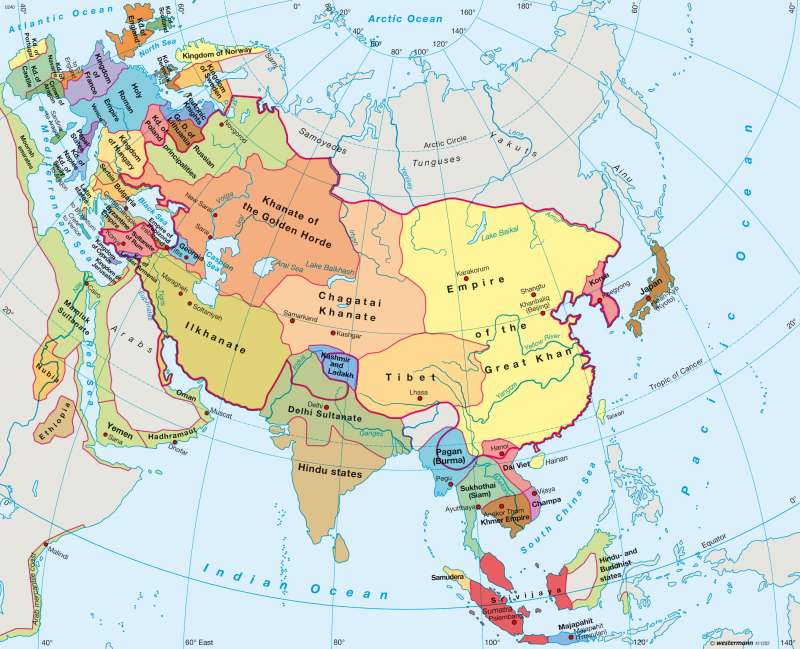Asia circa 1300
Asia - Countries and history
978-3-14-100790-9 | Page 92 | Ill. 2

Information
The map shows the Mongol Empire at the time of its greatest extent in around 1300. The vast expansion of the Mongols was largely the work of Prince Temujin (1167-1227), who called himself Genghis Khan (from 1206) "ruler of the world". As a superior general, he gathered the best horsemen in the world. Within just two years, he united the Mongol peoples and started a permanent conquest with them. Upon his death in 1227, he was acknowledged as the ruler of a well-organised empire, which stretched across Central Asia, Persia, northern Caucasus and northern China, including Beijing. His sons, among whom he had divided his kingdom, and his grandson, continued the expansion. In 1259, the Mongols entered Western Asia and Europe and in 1279, they initially resisted the Southern Sung empire in China, which they eventually conquered.The Mongol Khanate
In the divided kingdom of the Great Khan, established by Kublai Khan, (Yuan dynasty 1279-1368), which extended over large parts of present-day China, the population became four groups. The ruling class was made up solely of the Mongols and Tatars. The "auxiliaries" such as Turks, Persians, Syrians and Arabs formed a middle class of businessmen and senior officials. The northern Chinese were practicing crafts, operated retails and occupied local administrations, while the southern Chinese, the majority of the population, were completely without rights. Intermarriage between the groups was banned and this rule was monitored by Mongolian inspectors.
Chagatai was the most strongly influenced by Mongolian Khanate culture. Evidence is that the Mongolians here vainly resisted the advance of Islam for a long time. The influence of Persian-Islamic culture during the 14th century had become obvious by the 15th century. Chagatai disintegrated into a multitude of principalities, emirates, cities and oasis states.
The Khanate of the Golden Horde had become rich through the mastery of important caravan routes, from customs and toll revenue. It was significant for the subsequent history of Russia, that in 1332, the Prince of Moscow was responsible for collecting the Tatar tribute and was elevated by the Mongols to the Grand Duke. In the 16th century, the empire of the Golden Horde was conquered by Tsar Ivan the Terrible.
The Ilkhanat at the centre of Iran was conquered by the Mongols, but was not penetrated. As a thin upper layer, they were instructed in the imperial administration on the co-operation of the local population. By 1300, under Ghasan, the kingdom flourished. After his death, it was divided into a large number of warring principalities and emirates.
Tibet remained under the influence of the Mongols for a relatively short time, before falling to the Chinese Ming dynasty.
The Sultanate of Delhi was able to fend off the Mongols and expand during the 14th century, even towards the south, but was eventually plundered and devastated by Timur Läng in 1398 (1336-1405).
K. Lückemeier, E. Astor; Ü: C. Fleming




